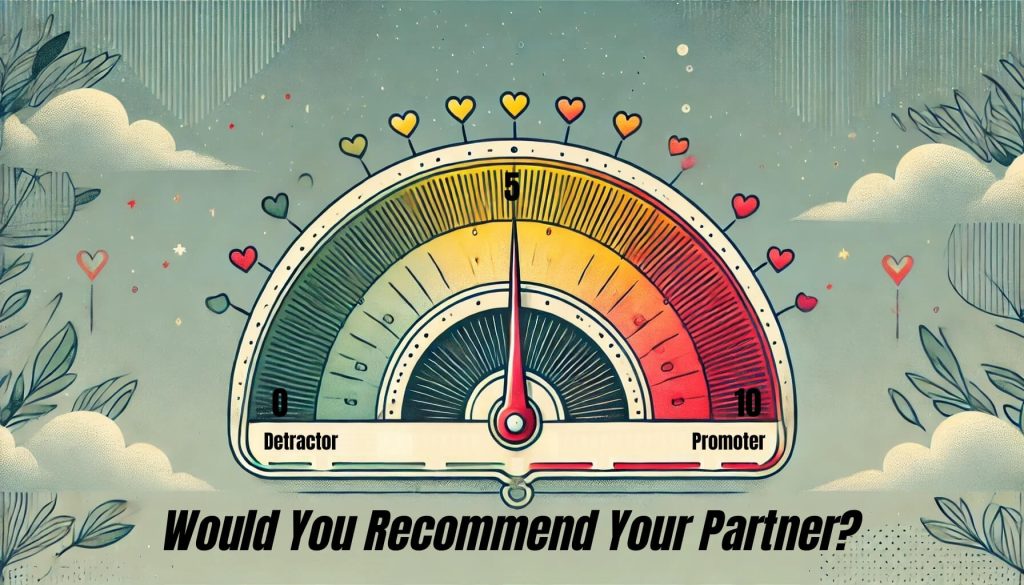The Power of the Net Promoter Score (NPS)
In marketing, one of the most effective tools for measuring customer satisfaction and loyalty is the Net Promoter Score (NPS). This system revolves around a single, straightforward question:
“How likely is it that you would recommend [product/service/company] to a friend or colleague?”
Customers respond on a 10-point scale, which marketers use to group them into three categories:
- Promoters (9-10): These are your brand champions—loyal, satisfied customers who are eager to recommend your product or service.
- Passives (7-8): These customers are generally satisfied but lack enthusiasm. They won’t actively promote your brand, but they’re not likely to discourage others either.
- Detractors (0-6): These are unhappy customers who may harm your brand by sharing negative experiences or discouraging others from engaging with you.
NPS offers a clear snapshot of not only customer satisfaction but also advocacy potential. It’s not just about whether customers are happy; it’s about whether they believe your brand is worth vouching for.

What Marketers Do at Each NPS Level
If a Customer Scores a 9-10 (Promoter)
Promoters are a goldmine for any business. These customers love what you do and are likely to become brand advocates. Marketers focus on nurturing these relationships to maximize their positive impact.
Action Steps for Marketers:
- Encourage Advocacy: Prompt promoters to leave reviews, share testimonials, or refer friends through referral programs.
- Reward Loyalty: Offer loyalty benefits or exclusive perks to show appreciation for their support.
- Listen to Feedback: Ask them what they love most about your product or service to amplify those strengths.
- Deepen Engagement: Keep them engaged with targeted content, special offers, or behind-the-scenes updates that make them feel like insiders.
Promoters not only bring in new customers but also create a ripple effect of trust and credibility for your brand.
If a Customer Scores a 7-8 (Passive)
Passives are satisfied but unenthusiastic. They aren’t harming your brand, but they aren’t actively helping it either. For marketers, passives represent an opportunity to turn lukewarm satisfaction into enthusiastic loyalty.
Action Steps for Marketers:
- Identify Pain Points: Dig deeper to find out what’s keeping them from being fully satisfied. Is it the product, service, or price?
- Build Engagement: Use personalized offers, targeted promotions, or enhanced communication to reignite their excitement about your brand.
- Provide Surprise Value: Sometimes, an unexpected gesture—like a free upgrade or handwritten thank-you—can push passives into promoter territory.
- Ask for Feedback: Solicit detailed feedback to understand what would make their experience better.
The goal with passives is to convert them into promoters by addressing their hesitations and exceeding their expectations.
If a Customer Scores a 0-6 (Detractor)
Detractors are not just unhappy—they have the potential to actively damage your brand. For marketers, this group requires immediate attention and a proactive approach to resolve issues and prevent further harm.
Action Steps for Marketers:
- Address Concerns Quickly: Follow up with detractors to understand the root of their dissatisfaction and resolve their issues. Speed is critical here.
- Apologize and Compensate: A sincere apology and an appropriate gesture—such as a refund, replacement, or discount—can help repair the relationship.
- Listen Without Defensiveness: Make them feel heard and valued by genuinely listening to their feedback, even if it’s harsh.
- Identify Patterns: If detractors frequently raise the same issues, it’s a sign of systemic problems that need fixing.
- Follow Up Post-Resolution: After resolving their concerns, check back to see if the customer’s perception has improved.
While not all detractors can be turned into promoters, many can be pacified or even converted into loyal customers through thoughtful intervention.
Applying the Ultimate Question to Marriage
What if you could use a similar question to assess your marriage? Consider this variation:
“Imagine you and your partner are no longer together, and you feel at peace with the situation. If someone asked whether they should date your partner, how likely would you be to recommend them on a scale of 0 to 10?”
This version applies the same clarity and structure as NPS, but for your relationship. Your answer to this question offers valuable insights into how you view your partner, your relationship, and what’s working—or not.

The Scale in Marriage
Here’s how the NPS scale translates to marriage:
- 9-10 (Promoter): You’d enthusiastically recommend your partner. They’re kind, supportive, and everything you’d want in a spouse. If you weren’t already married, you’d gladly choose them again.
- 7-8 (Passive): You’d recommend them with some hesitation. They’re a good partner, but there’s room for improvement—perhaps in communication, connection, or shared goals.
- 0-6 (Detractor): You wouldn’t recommend them—or might even actively discourage someone from dating them. This could indicate deeper issues like lack of trust, chronic unhappiness, or incompatibility. A score this low might mean it’s time to seek help, like counseling, or reevaluate the relationship.
Bridging the Gap
Once you’ve identified your score, the next step is reflection. If your score isn’t a 9 or 10, it’s worth asking: What’s holding it back? Are there specific pain points in your marriage that are lowering the score? These might include communication breakdowns, unmet emotional needs, or a lack of alignment in goals. Alternatively, consider what changes could help elevate your relationship to a 9 or 10. Would improving physical intimacy, spending more quality time together, or working on conflict resolution make a difference? By pinpointing the areas for growth, you can create a roadmap to strengthen your relationship and build a partnership you’d wholeheartedly recommend.

Reflecting on Your Marriage
To understand your score, let’s break it down into areas that make or break a relationship:
1. Emotional Connection
A marriage thrives on emotional intimacy. Promoters likely feel deeply connected to their partner and experience consistent emotional support. Passives may feel the connection is occasional or surface-level. Detractors might feel disconnected or even neglected.
What to Improve: If your emotional connection isn’t strong, start by carving out time for meaningful conversations, being vulnerable, and actively listening to each other.
2. Communication Skills
Promoters describe their partners as excellent communicators who address conflicts constructively and express themselves clearly. Passives might find communication inconsistent, while detractors likely face frequent miscommunications or unresolved conflicts.
What to Improve: Consider learning healthy communication techniques, like using “I” statements, practicing active listening, or attending couples’ workshops.
3. Reliability and Trust
Promoters feel their partner is dependable, honest, and supportive. Passives might see gaps in reliability or consistency. Detractors may struggle with broken trust or unmet expectations.
What to Improve: Trust can be rebuilt with small, consistent actions over time. Follow through on promises, show up when needed, and be honest—even in difficult conversations.
4. Physical and Emotional Intimacy
Promoters enjoy a balance of physical affection and emotional closeness. Passives might feel intimacy is sporadic or unbalanced. Detractors might feel unfulfilled or disconnected in this area.
What to Improve: Openly discuss your needs and desires with your partner. Prioritize intimacy as an essential part of your relationship, not an afterthought.
5. Shared Goals and Values
Promoters likely share a strong vision for the future with their partner, aligned on life goals and values. Passives may feel misaligned in some areas, and detractors may feel their goals are in conflict altogether.
What to Improve: Regularly revisit your shared goals and values. Identify areas of misalignment and work together to find common ground.

Why This Exercise Matters
The ultimate question forces you to reflect on your relationship from a different perspective. By imagining yourself outside the relationship, you strip away day-to-day frustrations and focus on the core qualities of your partner and your dynamic.
Like in marketing, this reflection isn’t about blame—it’s about identifying strengths and opportunities for improvement. Whether your “score” is high, low, or somewhere in between, the goal is to use this insight to build a stronger, more fulfilling relationship.
The Final Question
So, ask yourself:
“If someone asked whether they should date your partner, how likely would you be to recommend them on a scale of 0 to 10?”
Your answer can guide you toward a deeper understanding of your relationship and help you take the next steps to strengthen or reevaluate it. But don’t stop there—take a moment to consider how your partner might rate you in the relationship. Would they enthusiastically recommend you as a spouse, or would they have suggestions for growth? Can you identify what might cause your partner to lower their score, and if not, it’s time to have an open conversation to find out. Reflecting on both perspectives can help you uncover ways to fine-tune the good, address the challenges, and work toward building a partnership that both of you would proudly recommend. This exercise isn’t about blame—it’s a tool for growth and for creating a marriage worth celebrating.



